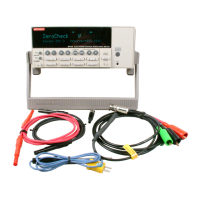Note: 5 counts on the 200µA range equals 000.005µA
Thus, the accuracy range for a 100.000µA reading is
99.895µA to 100.105µA.
V-Source accuracy (100V on the 100V range) is calculated
as follows:
Accuracy = ±(% setting + offset)
= ±(0.15% of 100V + 10mV)
= ±(0.15V + 0.01V)
= ±(0.16V)
Thus, the accuracy range for the 100V V-Source setting is
99.84V to 100.16V.
Ohms can then be calculated (R = V/I) using amps and
V-Source accuracy as follows:
Thus, the accuracy range for the 01.0000MΩ Manual V-
Source reading is 00.9974MΩ to 01.0027MΩ.
A.1.4 Calculating coulombs accuracy
From the specifications, Coulombs is calculated as follows:
Accuracy = ±(% rdg + counts)
The following example shows how to compute accuracy for
the 2µC range:
Assume that the charge you are measuring is reading exactly
1.00000µC on the 2µC range.
From the specs:
Accuracy = ±(0.4% of 1µC + 5 counts)
= ±(0.004µC + 5 counts)
= ±(0.004µC + 0.00005µC)
= ±0.00405µC
Note: 5 counts on the 2µC range equals 0.00005µC
Thus, the accuracy range for the 1.00000µC reading is
0.99595µC to 1.00405µC.
Ohms Upper Limit Accuracy =
100.16V
99.895µA
------------------------
Ohms Upper Limit Accuracy = 1.00265M‰
Ohms Lower Limit Accuracy =
99.84V
100.105µA
---------------------------
Ohms Upper Limit Accuracy = 0.99735M‰
Accuracy = –2650‰
A.1.5 Calculating Resistance/Resistivity Accuracy
and Repeatability using the Alternating
Polarity Method
From the specifications, accuracy and repeatability when using
a Model 8002A or 8009 test fixture are calculated as follows:
Repeatability: ∆I
BG
× R/ V
ALT
+ 0.1% (1σ)
(instrument temp. constant ±1°C)
Accuracy: (V
SRC
Err + I
MEAS
Err × R)/V
ALT
where: • ∆I
BG
is a measured, typical background cur-
rent noise from the sample and fixture over the
measurement time programmed, under normal
measurement conditions (1 PLC, same range,
filters off, etc.).
• V
ALT
is the alternating polarity voltage used.
• V
SRC
Err is the accuracy (in volts) of the volt-
age source using V
ALT
as the setting.
• I
MEAS
Err is the accuracy (in amps) of the am-
meter using V
ALT
/R as the reading.
The following example shows how to calculate accuracy and
repeatability for a 10
13
ohms sample measured in a Model
8009 test fixture, with 50V stimulus and a background current
of 4pA. The user-selected measurement time for the Alternat-
ing Polarity measurement is 15 seconds.
∆I
BG
is measured with no voltage applied, under normal mea-
surement conditions, and 15 seconds (according to the user’s
choice for the measurement) of readings are stored to the buffer.
Normal conditions require 1 PLC, the same amps range that
will be used for the Alternating Polarity measurement and sim-
ilar preconditioning to the normal measurements. (If the sam-
ples are normally inserted into the fixture and immediately
measured, the stored readings should be performed similarly af-
ter lid closure, etc.) After the storage is complete, the standard
deviation (1 sigma) of these values is taken. This can be done
by retrieving the standard deviation of the buffer over the bus or
by pressing RECALL once and NEXT repeatedly, scrolling
through the second-line displays to the standard deviation. This
is ∆I
BG
. Assume for example, that the result was 55fA or
5.5×10
-14
A.
Repeatability = 5.5×10
-14
A × 10
13
Ω / 50V + 0.1% = 0.011
+ 0.1% or 1.2%
Note that with normal ohms methods, the 4pA total back-
ground current contributes as much as 400% error.
V
SRC
Err = 0.15% × 50V + 10mV = 0.085V (from 100V
V-source range specs)
I
MEAS
Err = 1% × (50V / 10
13
Ω) + 30 counts × 10
-16
A /
count = 5.3×10
-14
A (from 20pA spec)
Accuracy = (0.085V + 5.3×10
-14
A × 10
13
Ω) / 50V = 0.0123
or 1.23%
A-6 Specifications

